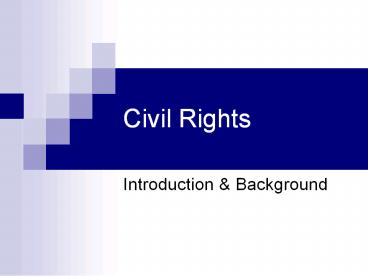Civil Rights - PowerPoint PPT Presentation
1 / 16
Title:
Civil Rights
Description:
Civil Rights Introduction & Background Introduction Does treating people equally mean treating them the same? A man & woman apply for job as shoe sales person 2 ... – PowerPoint PPT presentation
Number of Views:84
Avg rating:3.0/5.0
Title: Civil Rights
1
Civil Rights
- Introduction Background
2
Introduction
- What are civil rights?
- Where are they guaranteed?
- Rights to full legal, economic, political
social equality by virtue of citizenship - Guaranteed in U.S. Constitution (including 13th
14th Amendments) acts of Congress (civil
liberties, due process, equal protection, freedom
from discrimination)
- Does treating people equally mean treating them
the same? - A man woman apply for job as shoe sales person
- 2 patients come to the doc with a headache. 1 has
a brain tumor the other a headache.. - 2 students enter school with stairs to entrance.
1 is in a wheelchair - 2 students live in the same school district. They
are the same age but different races
3
History of Civil Rights
- Colonial America
- Early slavery
- 1800s
- Abolition movement End slavery (Frederick
Douglass) - Civil War 1860-65
- Reconstruction
- 13th -
- 14th -
- 15th -
- Late 1800s
- Legalized racism in the South (Jim Crow laws)
4
Early Figures
- Booker T. Washington
- Blacks should work within the systems
- Economic value
- Ex. Tuskegee School
- WEB DuBois
- Founded NAACP
- End racism, violence segregation
- Improve legal rights
- Used the courts to achieve change
5
Atlanta Compromise
- No race can prosper till it learns that there
is as much dignity in tilling a field as in
writing a poem. It is not at the bottom of life
we must begin, not at the top. Nor should we
permit our grievances to overshadow our
opportunities In all things that are purely
social we can be as separate as the fingers, yet
as one hand in all things essential to mutual
progress. - - Booker T. Washington
6
Important Events
- Plessy v. Ferguson 1896
- Upheld constitutionality of racial segregation
- Railroads
- separate but equal is OK
- Great Depression
- 1930s Blacks suffered as a group gt voted for New
Deal - Shift from voting for Republicans to Democrats
- FDR fails civil rights because he fears lack of
support from whites
7
Early Civil Rights Victories
1940 NAACP Legal Defense Fund founded by Thurgood Marshall
1941 Ban against discrimination in defense industry (A. Phillip Randolph)
1942 Funding of CORE
1947 Integration of MLB with Jackie Robinson
1948 Truman desegregates military
8
Integrating Schools
- Brown v. Board of Education
- Separate schools for blacks whites violates the
Constitutions guarantee of equal protection - Clear ruling but lack of enforcement or deadline
9
School Integration continued
- Little Rock Nine
- 1957 Gov. Orval Faubus violated court order to
integrate Arkansas - 9 Black students harassed on 1st day of school
- Eisenhower tried to talk to Gov. but Sept. 24th
he announced on TV sending in federal troops
10
Little Rock Nine
11
Montgomery Bus Boycott
- Bus segregation in Montgomery, Alabama
- Blacks made up 2/3 of all riders
- Couldnt sit in front rows, couldnt share row
with whites - In 1955, Rosa Parks sat in the black section but
when the white section filled, she refused to
move gt arrested
12
(No Transcript)
13
Boycott continued
- Boycott
- NAACP called for 1-day boycott (90 of riders
obliged) - Boycott led by Martin Luther King Jr.
- Churches set up carpools (rolling churches) but
whites denied insurance - 1956 Supreme Court ruled segregation on buses
unconstitutional
14
(No Transcript)
15
Non-Violent Resistance
- SCLC emerges
- Southern Christian Leadership Conference led by
MLK Jr. - Inspired by success of bus boycott
- Committed to non-violence
16
Non-Violent Influence
- Based on influence from Gandhi
- CORE SCLC used non-violence
- Organizations set up training on how to resist
passive behavior - Led to the sit-in movement































